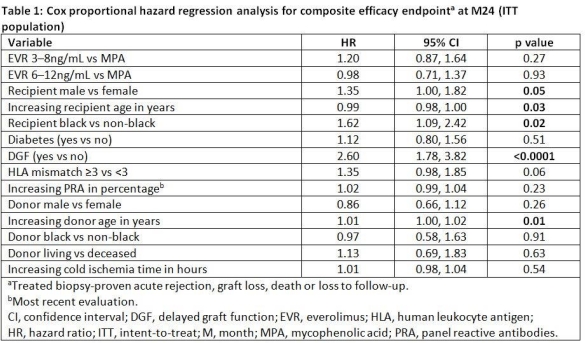Factors Affecting Efficacy Outcomes at 12 and 24-Months After Kidney Transplantation in Patients from the A2309 Study
1Novartis, Basel, Switzerland
2A2309 Study Group, Basel, Switzerland
3Novartis, East Hanover, NJ.
Meeting: 2015 American Transplant Congress
Abstract number: D126
Keywords: Efficacy, Kidney transplantation, Multivariate analysis, Risk factors
Session Information
Session Name: Poster Session D: Kidney Immunosuppression: Drug Minimization
Session Type: Poster Session
Date: Tuesday, May 5, 2015
Session Time: 5:30pm-6:30pm
 Presentation Time: 5:30pm-6:30pm
Presentation Time: 5:30pm-6:30pm
Location: Exhibit Hall E
Purpose: Efficacy outcomes post-transplantation are influenced by donor and recipient variables and interactions between them. Here, we present data from a multivariate analysis of risk factors like age, gender, race and delayed graft function (DGF) that might influence efficacy outcomes in de novo kidney transplant recipients (KTxR).
Methods: A2309 (NCT00251004) was a 24-month (M), multicenter, open-label trial randomizing KTxR (1:1:1) to everolimus (EVR; C0 3–8 ng/mL or 6–12 ng/mL) with reduced cyclosporine (rCsA), or to mycophenolic acid (MPA) with standard (s) CsA; all with steroids. Primary endpoint was composite efficacy failure (treated biopsy proven acute rejection [tBPAR], graft loss, death or loss to follow-up) assessed at M12 and M24. Cox proportional hazard modeling was used to evaluate the potential impact of donor and recipient variables on the composite efficacy failure at M12 and M24.
Results: Overall 716 (86.0% of 833) patients completed the study. Composite efficacy failure occurred in 197 (23.6%) and 242 patients (29.1%) at M12 and M24 respectively. At M12, males (HR 1.50; 95% CI 1.08, 2.10; p=0.017), patients with HLA mismatch ≥3 (HR 1.42; 95% CI 1.00, 2.021; p=0.049), African-American patients (HR 1.68; 95% CI 1.08, 2.60; p=0.021) and patients with DGF (HR 2.75; 95% CI 1.82, 4.16; p<0.001) were at a significantly higher risk of composite efficacy failure. Risk was higher with increasing donor age (HR 1.01; 95% CI 1.00, 1.03; p=0.022). At M24, increasing recipient age was associated with significantly lower risk. However, males, African-American patients, patients with DGF remained significantly associated with higher risk of composite efficacy failure (Table 1). EVR (C0 3–8 or 6–12 ng/mL)+rCsA vs MPA+sCsA showed no significant association with risk of the composite efficacy failure.
Conclusion: Among the several donor and recipient variables associated with efficacy outcomes at M12 and M24, patients with DGF were at highest risk. Choice of immunosuppressive regimen was not associated as a risk factor, confirming similar efficacy with EVR+rCsA vs MPA+sCsA regimens. 
To cite this abstract in AMA style:
Escrig C, Colussi G, Roland R, Vergara M, Wang Z. Factors Affecting Efficacy Outcomes at 12 and 24-Months After Kidney Transplantation in Patients from the A2309 Study [abstract]. Am J Transplant. 2015; 15 (suppl 3). https://atcmeetingabstracts.com/abstract/factors-affecting-efficacy-outcomes-at-12-and-24-months-after-kidney-transplantation-in-patients-from-the-a2309-study/. Accessed November 30, 2025.« Back to 2015 American Transplant Congress
